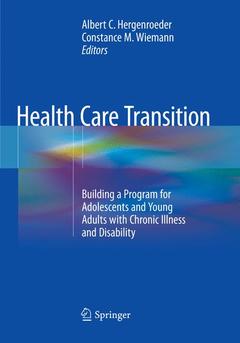Description
Health Care Transition, 1st ed. 2018
Building a Program for Adolescents and Young Adults with Chronic Illness and Disability
Coordinators: Hergenroeder Albert C., Wiemann Constance M.
Language: English
Subjects for Health Care Transition:
Publication date: 01-2019
Support: Print on demand
Publication date: 05-2018
Support: Print on demand
Description
/li>Contents
/li>Biography
/li>Comment
/li>
This comprehensive book thoroughly addresses all aspects of health care transition of adolescents and young adults with chronic illness or disability; and includes the framework, tools and case-based examples needed to develop and evaluate a Health Care Transition (HCT) planning program that can be implemented regardless of a patient?s disease or disability. Health Care Transition: Building a Program for Adolescents and Young Adults with Chronic Illness and Disability is a uniquely inclusive resource, incorporating youth/young adult, caregiver, and pediatric and adult provider voices and perspectives.
Part I of the book opens by defining Health Care Transition, describing the urgent need for comprehensive transition planning, barriers to HCT and then offering a framework for developing and evaluating health care transition programs. Part II focuses on the anatomic and neuro-chemical changes that occur in the brain during adolescence and young adulthood, and how they affect function and behavior. Part III covers the perspectives of important participants in the HCT transition process ? youth and young adults, caregivers, and both pediatric and adult providers. Each chapter in Part IV addresses a unique aspect of developing HCT programs. Part V explores various examples of successful transition from the perspective of five key participants in the transition process - patients, caregivers, pediatric providers, adult providers and third party payers. Related financial matters are covered in part VI, while Part VII explores special issues such as HCT and the medical home, international perspectives, and potential legal issues. Models of HCT programs are presented in Part VIII, utilizing an example case study.Representing perspectives from over 75 authors and more than 100 medical centers in North America and Europe, Health Care Transition: Building a Program for Adolescents and Young Adults with Chronic Illness and Disability is an ideal resource for any clinician, policy maker, caregiver, or hospitalist working with youth in transition.
Chapter 2: The anatomical, hormonal and neuro-chemical changes that occur during brain development in adolescents and young adults
Chapter 3: The relationships of adolescent behaviours to adolescent brain changes; and their relevance to the transition of adolescents and young adults with chronic illness and disability
Chapter 4. Healthcare Transition from the AYASHCN’s perspective
Chapter 5: Health Care Transition from the Family Perspective
Chapter 6. Healthcare Transition from the Pediatric Provider’s Perspective
Chapter 7: Healthcare Transition from the Adult Provider’s Perspective Barriers to accepting AYASHCN in the practice
Chapter 8: Healthcare Insurance Changes
Chapter 9. Establishing the Administrative Structure and Support for a Healthcare Transition Program
Chapter 10: Mobilizing Pediatric Providers
Chapter 11: Developing a Transition Policy, Procedures or Guidelines
Chapter 12: Establishing a Method to Monitor Transition Planning and Track Patient Outcomes Following Transfer
Chapter 13: Incorporating Healthcare Transition Readiness Assessment
Chapter 14. Employing Healthcare Transition Planning Tools
Chapter 15. Understanding the Pediatric and Adult Healthcare System: Adapting to Change
Chapter 16. Developing the Process for Transferring Care from Pediatric to Adult Providers
Chapter 17. Preparing the Adult Practice to Accept AYA
Chapter 18: Establishing a System for Ensuring Transfer Completion
Chapter 19. Defining Successful Transition: Young Adult Perspective
Chapter 20. Defining Successful Transition: Parent PerspectiveChapter 21. Defining Successful Transition: Pediatric Provider Perspective
Chapter 22. Defining Successful Transition: Adult Provider Perspective
Chapter 23. Defining Successful Transition: Payer perspective
Chapter 24 Financial Cost of Healthcare Transition
Chapter 25. Payment for Health Care Transition Services
Chapter 26: Healthcare Transition and the Medical Home
Chapter 27. The Hospitalist’s Perspective on Healthcare Transition
Chapter 28. The International Perspective on Health care Transition
Chapter 29: Expanding the Role of the Pharmacist
Chapter 30: Legal Issues: Guardianship and supportive decision making
Chapter 31. Transitioning Adolescents and Young Adults with Medical Complexity
Chapter 32. Transitioning Youth with Cognitive and Intellectual Disabilities
Chapter 33: Palliative Care in Adolescents and Young Adults with Special Healthcare Needs
Chapter 34: Healthcare Transitions and Dental Care
Chapter 35. A Successful Healthcare Transition Program in a Hospital Setting
Chapter 36: Different Healthcare Transition Models
Chapter 37: Conclusions
Constance M. Wiemann, PhD
Associate Professor, Director of Research
Section of Adolescent Medicine and Sports Medicine
Department of Pediatrics
Baylor College of Medicine
Texas Children’s Hospital
Houston, Texas
Albert C. Hergenroeder, MD
Professor, Chief of Adolescent Medicine
Section of Adolescent Medicine and Sports Medicine
Department of Pediatrics
Baylor College of Medicine
Texas Children’s Hospital
Houston, TexasProvides a Health Care Transition planning program focus that can be adopted across diseases, disabilities and settings
Includes voices of youth and young adults, caregivers, and both pediatric and adult providers, providing a diversity of perspectives and contexts
Written by experts in the field




